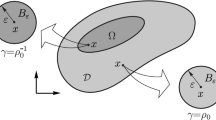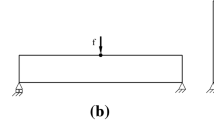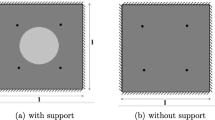Abstract
In this paper the topological derivative concept is applied in the context of compliance topology optimization of structures subject to design-dependent hydrostatic pressure loading under volume constraint. The topological derivative represents the first term of the asymptotic expansion of a given shape functional with respect to the small parameter which measures the size of singular domain perturbations, such as holes, inclusions, source-terms and cracks. In particular, the topological asymptotic expansion of the total potential energy associated with plane stress or plane strain linear elasticity, taking into account the nucleation of a circular inclusion with non-homogeneous transmission condition on its boundary, is rigorously developed. Physically, there is a hydrostatic pressure acting on the interface of the topological perturbation, allowing to naturally deal with loading-dependent structural topology optimization. The obtained result is used in a topology optimization algorithm based on the associated topological derivative together with a level-set domain representation method. Finally, some numerical examples are presented, showing the influence of the hydrostatic pressure on the topology of the structure.








Similar content being viewed by others
References
Amigo RCR, Giusti SM, Novotny AA, Silva ECN, Sokolowski J (2016) Optimum design of flextensional piezoelectric actuators into two spatial dimensions. SIAM J Control Optim 52(2):760–789
Ammari H, Kang H (2007) Polarization and moment tensors with applications to inverse problems and effective medium theory Applied Mathematical Sciences, vol 162. Springer-Verlag, New York
Amstutz S (2011) Analysis of a level set method for topology optimization. Optimization Methods and Software 26(4-5):555–573
Amstutz S, Andrä H (2006) A new algorithm for topology optimization using a level-set method. J Comput Phys 216(2):573–588
Amstutz S, Novotny AA (2010) Topological optimization of structures subject to von Mises stress constraints. Struct Multidiscip Optim 41(3):407–420
Amstutz S, Giusti SM, Novotny AA, de Souza Neto EA (2010) Topological derivative for multi-scale linear elasticity models applied to the synthesis of microstructures. Int J Numer Methods Eng 84:733–756
Amstutz S, Novotny AA, de Souza Neto EA (2012) Topological derivative-based topology optimization of structures subject to Drucker-Prager stress constraints. Comput Methods Appl Mech Eng 233–236:123–136
Campeão DE, Giusti SM, Novotny AA (2014) Topology design of plates consedering different volume control methods. Eng Comput 31(5):826–842
Céa J, Garreau S, Guillaume Ph, Masmoudi M (2000) The shape and topological optimizations connection. Comput Methods Appl Mech Eng 188(4):713–726
Chen BC, Kikuchi N (2001) Topology optimization with design-dependent loads. Finite Elem Anal Des 37:57–70
Du J, Olhoff N (2004a) Topological optimization of continuum structures with design-dependent surface loading - Part I: new computational approach for 2d problems. Struct Multidiscip Optim 27(3):151–165
Du J, Olhoff N (2004b) Topological optimization of continuum structures with design-dependent surface loading - Part II: algorithm and examples for 3d problems. Struct Multidiscip Optim 27(3):166–177
Eshelby JD (1957) The determination of the elastic field of an ellipsoidal inclusion, and related problems. Proceedings of the Royal Society: Section A 241:376–396
Eshelby JD (1959) The elastic field outside an ellipsoidal inclusion, and related problems. Proceedings of the Royal Society: Section A 252:561–569
Fuchs MB, Shemesh NNY (2004) Density-based topological design of structures subjected to water pressure using a parametric loading surface. Struct Multidiscip Optim 28(1):11–19
Gao T, Zhang W (2009) Topology optimization of multiphase-material structures under design dependent pressure loads. Int J Simul Multidiscip Des Optim 3:297–306
Garreau S, Guillaume Ph, Masmoudi M (2001) The topological asymptotic for PDE systems: the elasticity case. SIAM J Control Optim 39(6):1756–1778
Hammer VB, Olhoff N (2000) Topology optimization of continuum structures subjected to pressure loading. Struct Multidiscip Optim 19:85–92
Kachanov M, Shafiro B, Tsukrov I (2003) Handbook of Elasticity Solutions. Kluwer Academic Publishers, Dordrecht
Lee E, Martins JRRA (2012) Structural topology optimization with design-dependent pressure loads. Comput Methods Appl Mech Eng 233-236:40–48
Lopes CG, Santos RB, Novotny AA (2015) Topological derivative-based topology optimization of structures subject to multiple load-cases. Latin American Journal of Solids and Structures 12:834–860
Mróz Z, Giusti SM, Sokolowski J, Novotny AA (2017) Topology design of thermomechanical actuators. Struct Multidiscip Optim (to appear):1–15
Norato JA, Bendsøe MP, Haber RB, Tortorelli D (2007) A topological derivative method for topology optimization. Struct Multidiscip Optim 33(4–5):375–386
Novotny AA, Sokołowski J (2013) Topological derivatives in shape optimization. Interaction of Mechanics and Mathematics. Springer-Verlag, Berlin Heidelberg
Novotny AA, Feijóo RA, Padra C, Taroco E (2003) Topological sensitivity analysis. Comput Methods Appl Mech Eng 192(7–8):803–829
Sá LFN, Amigo RCR, Novotny AA, Silva ECN (2016) Topological derivatives applied to fluid flow channel design optimization problems. Struct Multidiscip Optim 54(2):249–264
Sigmund O, Clausen PM (2007) Topology optimization using a mixed formulation: an alternative way to solve pressure load problems. Comput Methods Appl Mech Eng 196:1874–1889
Sokołowski J, żochowski A (1999) On the topological derivative in shape optimization. SIAM J Control Optim 37(4):1251– 1272
Torii AJ, Novotny AA, Santos RB (2016) Robust compliance topology optimization based on the topological derivative concept. Int J Numer Methods Eng 106(11):889–903
Wang C, Zhao M, Ge T (2016) Structural topology optimization with design-dependent pressure loads. Struct Multidiscip Optim 53(5):1005–1018
Wang MY, Xia Q, Shi T (2015) Topology optimization with pressure load through a level set method. Comput Methods Appl Mech Eng 283:177–195
Acknowledgments
This research was partly supported by CNPq (Brazilian Research Council), CAPES (Brazilian Higher Education Staff Training Agency) and FAPERJ (Research Foundation of the State of Rio de Janeiro). These supports are gratefully acknowledged.
Author information
Authors and Affiliations
Corresponding author
Appendix: Topological Derivative Evaluation
Appendix: Topological Derivative Evaluation
In order to evaluate the difference between the functionals \(\mathcal {J}_{\chi }(u)\) and \(\mathcal {J}_{\chi _{\varepsilon }}(u_{\varepsilon })\), respectively defined in (2.7) and (2.18), we start by taking η = u ε −u as test function in the variational problem (2.8). Then we have the following equality
After replacing (A.1) into (2.7) we obtain
In the same way, let us set η = u ε −u as test function in the variational problem (2.19). Thus
After replacing (A.3) into (2.18), it follows
From (A.2) and (A.4), the variation of the energy shape functionals can be written as
Now, by taking into account the definition for the contrast γ ε given by (2.17), we have
Let us add and subtract the term
Thus, the following expression is obtained after canceling the identical terms
Note that the variation of the energy shape functional results in an integral concentrated into the inclusion B ε . Therefore, in order to apply the definition for the topological derivative given by (2.2), we need to know the asymptotic behavior of the function u ε with respect the small parameter ε. Thus, let us introduce the following ansätz:
where u is solution of the unperturbed problem (2.7), w ε is solution to an auxiliary exterior problem and \(\tilde {u}_{\varepsilon }\) is the remainder.
After applying the operator σ ε in the ansätz (A.9) we have
By expanding σ(u) in Taylor’s series around the point \(\hat {x}\) we obtain
where ξ is an intermediate point between x and \(\hat {x}\). On the boundary of the inclusion B ε we have
After evaluating (A.12) we obtain
Then, let us evaluate (A.11) on ∂ B ε to have
since \((x - \hat {x}) = -\varepsilon n\) on ∂ B ε . By choosing σ ε (w ε ) such as
the following auxiliary boundary value problem is considered and formally obtained when \(\varepsilon \rightarrow 0\): Find σ ε (w ε ) such that:
with \(\hat {u} = ((\gamma - 1) \sigma (u)(\hat {x}) - \kappa p \mathrm {I})n\). The boundary value problem (A.16) admits an explicit solution. For p = 0, its solution can be found in (Novotny and Sokołowski 2013, Ch. 5, pp. 156), for instance. Since the stress σ ε (w ε ) is uniform inside the inclusion, the solution of (A.16) for p ≠ 0 can be written in a following compact form
where \(\mathbb {T}_{\gamma }\) is a fourth order isotropic tensor given by
and T γ is a second order isotropic tensor written as
The result shown in (A.17) fits the famous Eshelby’s problem. This problem, formulated by Eshelby (1957) and Eshelby (1959), represents one of the major advances in the continuum mechanics theory of the 20th century (Kachanov et al. 2003).
Now we can construct \(\sigma _{\varepsilon }(\tilde {u}_{\varepsilon })\) in such a way that it compensates for the discrepancies introduced by the higher-order terms in ε as well as by the boundary-layer w ε on the exterior boundary \(\partial \mathcal {D}\). It means that the remainder \(\tilde {u}_{\varepsilon }\) must be solution to the following boundary value problem: Find \( \tilde {u}_{\varepsilon }\) such that:
with h = (1−γ)(∇σ(u(ξ))n)n. The estimate \(\|\tilde {u}_{\varepsilon }\|_{H^{1}(\mathcal {D})} = O(\varepsilon ^{2})\) for the remainder \(\tilde {u}_{\varepsilon }\) holds true. See, for instance, the book by Novotny and Sokołowski (2013, Ch. 5, pp 155).
From the above results, we can evaluate the integrals in (A.8) explicitly. In fact, after replacing the ansätz for u ε given by (A.9) in the first integral of (A.8) we have
The remainder \(\mathcal {E}_{1}(\varepsilon )\) is given by
where we have used the Cauchy-Schwarz inequality together with the estimation for the remainder \(\tilde {u}_{\varepsilon }\). The term (a) in (A.21) can be developed in power of ε as follows
with the remainder \(\mathcal {E}_{2}(\varepsilon )\) defined as
where we have introduced the notation
Note that, we have used again the Cauchy-Schwarz inequality and the interior elliptic regularity of function u. Since the exact solution of the auxiliary problem (A.16) is known, the term (b) in (A.21) can be written as
The remainder \(\mathcal {E}_{3}(\varepsilon )\) is given by
where we have used again the Cauchy-Schwarz inequality and the interior elliptic regularity of function u.
The second term in (A.8) can be developed as follows
where the remainder \(\mathcal {E}_{4}(\varepsilon )\) is defined as
Once again, we have used the Cauchy-Schwarz inequality together with the interior elliptic regularity of function u.
After replacing the ansätz for u ε given by (A.9) into the last term of (A.8) we have
where the remainder \(\mathcal {E}_{5}(\varepsilon )\) has the following bound thanks to the estimate for \(\tilde {u}_{\varepsilon }\)
By using the constitutive relation and after algebraic manipulations, we have
where trσ ε (w ε ), evaluated inside the inclusion, is given by
From the above results, the variation of the energy shape functionals, given by (A.8), can be developed in power of ε as follows
where the remainders \(\mathcal {E}_{i}(\varepsilon ) = o(\varepsilon ^{2})\), for i = 1,...,5, as previously shown. By defining the function f(ε) = π ε 2 and after applying the topological derivative concept in (A.34), we obtain
where \(\mathbb {P}_{\gamma }\) is a fourth order isotropic tensor given by Ammari and Kang (2007)
with the coefficients α and β defined as
Rights and permissions
About this article
Cite this article
Xavier, M., Novotny, A.A. Topological derivative-based topology optimization of structures subject to design-dependent hydrostatic pressure loading. Struct Multidisc Optim 56, 47–57 (2017). https://doi.org/10.1007/s00158-016-1646-4
Received:
Revised:
Accepted:
Published:
Issue Date:
DOI: https://doi.org/10.1007/s00158-016-1646-4




